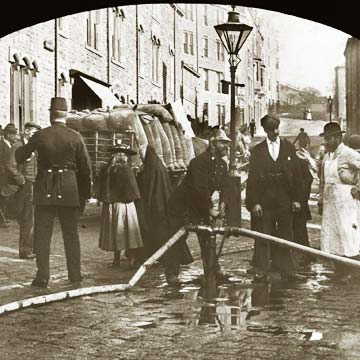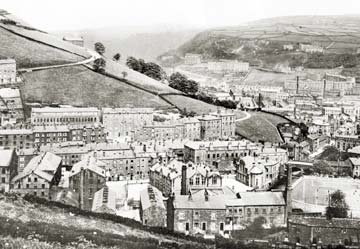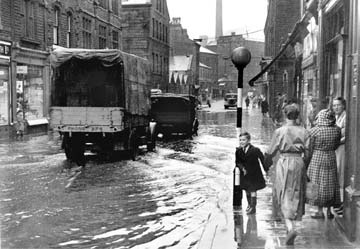|
Home Subscriptions Send us your memories Buy online Links ISSUE 13 CONTENTS Flying the Flag for the 21st Century
|
"A Thirst for Knowledge" Hebden Bridge Literary and Scientific Society Issy Shannon Looks Back Over One Hundred Remarkable Years Research by Diana Monahan
An early example of the camera in action! A tremendous thirst for knowledge was the driving force behind Hebden Bridge Literary and Scientific Society, established on December 4 1905. There were already several mutual improvement societies in the area providing an invaluable outlet for the working man and woman. Yet a need was felt for an organisation of a different kind: one with the avowed purpose of encouraging the intensive study of natural history, literature, "physical science" and other topics that members themselves would initiate.
Central Street School, where the first meetings of the HBLSS took place, stands out prominently in this rare view of Hebden Bridge circa 1910. Heptonstall Road snakes up the hillside, top left, and Market Street runs from left to right. The playground of the Secondary School, opened in 1909 and just visible, right, helps to date the photo. Ref CT085KI HBLSS The founder was Mr William Nowell, a noted botanist, who put forward his ideas to like-minded supporters at a meeting at Central School, Hebden Bridge, in November 1905. The proposal met with enormous enthusiasm and a month later the inaugural meeting, chaired by Dr James Brown, was held at which the three-point objectives of the new society were declared: "To carry out the further education of the inhabitants of Hebden Bridge by means of assembling together to read and hear papers on subjects kindred to such an Association. By arranging rambles for the study of natural history. To stimulate interest in educational facilities." Membership of the General Society was 133 in the first year, reaching a peak of 1,640 in 1943 by which time there were many more sections. The rules provided that new sections could be formed by any three members with a particular interest falling within the society's constitution and soon the Natural History Section (which survived until 1959) had been joined by the Photographic (1905 - `60) and Literary Sections. Together with astronomy (originally formed in 1918 by a small group of enthusiasts led by "Greeny" Horsfall - Sir Bernard Ingham's maternal grandfather) Local History is the only section to survive to the present day. Marking the Golden Anniversary of the HBLSS in 1955- and still very active in the society's affairs - founder William Nowell attributed its success to a willingness to change with the times: "As I see it the most important factor is that, while maintaining its general appeal, the organisation has been elastic enough to provide a means of association for any sectional interest, whether it be astronomy or beekeeping. That has been the secret of its success." Little could those founder members, eager to learn and share their knowledge in a world on the brink of cataclysmic change, have foreseen what was in store for their descendants 100 years later. Much has changed beyond all recognition but the values and principles of the HBLSS remain as strong and relevant as ever. The story in full is told in issue 13 of "Milltown memories" and the special commemorative booklet, both available from local outlets and the publishers.
Read the full story in Milltown Memories, issue 13. If this or other stories stirs a memory, we'd be happy to know - send us your memories and comments. |



